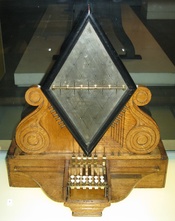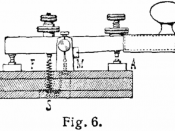The Importance of the Telegraph
The telegraph is an electromagnet connected to a battery via a switch. When the switch is down, the current flows from the battery through the key, down the wire, and into the sounder at the other end of the line. By itself, the telegraph could express only two states, on or off. This limitation was eliminated by the fact that it was the duration of the connection that determined the dot and dash from each other being short and long, respectively. From these combinations of dots and dashes the Morse code was formed. The code included all the letters of the English alphabet, all the numbers and several punctuation marks. A variation to the telegraph was a receiving module that Morse had invented. The module consisted of a mechanically operated pencil and a roll of paper. When a message was received, the pencil would draw the corresponding dashes and dots on the paper to be deciphered later.
The electric telegraph was one of the first telecommunication technologies of the industrial age. By transmitting information quickly over long distances, the telegraph facilitated the growth of the railroads, consolidated financial markets, and reduced the information costs between firms. Webster's definition of at telegraph is "an apparatus for communicating at a distance by coded signals." The earliest telegraphs consisted of smoke signals, drums, and mirrors used to reflect sunlight. In order to use these methods effectively, both the sender and receiver needed a method to interpret these signals. In 1791 the Frenchman, Claude Chappe used a visual network to send a message ten miles. This invention was called the telegraphe, or far writer. By 1779, his telegraph consisted of a network of towers with mechanical arms spread across France.
The telegraph is bases upon the principle that a...


